This is my absolute beginner’s guide to playing the ukulele and assumes no prior musical knowledge. The idea is that it’ll get you singing and playing lots of tunes, and it won’t have been a struggle. The ukulele is an easy instrument to learn and quickly rewarding. The most important thing to remember is to have fun with it and not get bogged down. If you’re finding anything tricky, have a cup of tea.

The ukulele to start with is a Soprano ukulele, the classic size for a ukulele. If you’re worried it will be too small, then go for a Tenor which is much more roomy for the sausage fingered. There are a lot of good ukuleles out there, but I’d advise you to get one with geared tuning pegs (that stick out of the side of the uke) rather than friction pegs (that come out of the back of the uke) because the geared tuning pegs tend to be better at keeping the strings in tune. I’d recommend any of Kala’s cheaper models as a great starter ukulele.
Getting your ukulele in tune is very important. If it’s not in tune, it’ll sound horrible and may put you off the whole idea, so pay close attention to this bit.
There are many ways to tune a ukulele, but the most common tuning is GCEA. This means that the string closest to your nose is tuned to a G (the one just above middle C), then (moving away from your nose) they are tuned to C, E, and A. Click the notes below to listen to these notes and tune up your ukulele.
To tune each string, you need to twist the tuning peg to which the string is attached. Tightening the string raises the note’s pitch, and loosening it lowers it (like when you twang a rubber band).
If you have a ukulele with friction pegs (without geared tuning pegs), you may find that the screws in the back of the pegs need to be tightened up to stop the strings from slipping. Just take a screwdriver and tighten them so you can still twist the peg but so that it stays firmly in place once you let go.
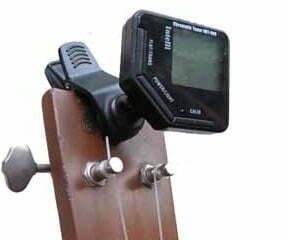
I’d recommend that you buy an electronic tuner, which you can buy at any music shop these days. Just clip it onto the head of your ukulele, and it tells you when the string you pluck is in tune. Remember, all ukuleles go out of tune, so check your tuning if it starts sounding rubbish.
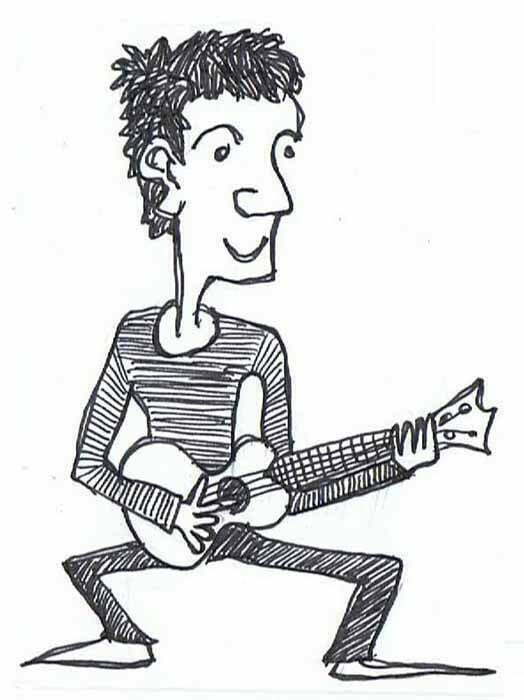
If you’re right-handed, hold the neck of your ukulele with your left hand so you can strum the strings with your right.
If you’re left-handed, hold the neck with the right hand and strum with the left (if you want to play your ukulele left-handed, see HERE for ideas on how to get started).
I tend to play sitting down, resting my ukulele on my lap, but you can employ various methods to play it standing up. One option is a strap, or you can tuck the body underneath your forearm.
Take your right forefinger and brush it across the strings. This should already sound quite nice. In fact, you’ve just played your first chord, which is called an ‘A Minor 7th’, so you can feel pretty pleased with yourself already. It should sound like this:
Some ukulele ‘experts’ get upset about people playing ukuleles with a plectrum. These people generally like to hang their ukuleles on the wall and not play them too much. You can use your fingers or a plectrum to play your uke.
In the Ukulele Orchestra, we use both, and they all sound great. If you want to use a plectrum, you’re best off using a harder guitar pick, not a floppy plastic one, as they can sound clacky. I have pretty tough nails, so I’ve grown mine – kind of grow-your-own plectrums. But you should feel free to use whatever suits you: nail, flesh or plastic; it’s only a ukulele.
A simple way for ukulele chords to be written is by using chord boxes. These are graphic representations of the first few frets of the neck of the ukulele, and they show you where to put your fingers to make a chord.
The vertical lines represent the strings, and the horizontal lines represent the frets. So, to play the chord of C, we would write a chord box that looks like this:
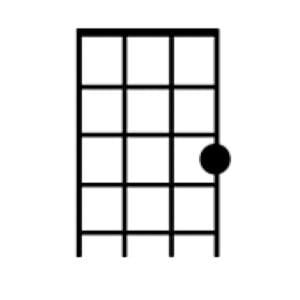

If this doesn’t make sense, take your ukulele and place a finger on the third fret of the top A string (the one furthest from your nose). This is a C chord. If you compare this to the chord box, it should begin to make sense.
Now, strum the strings. It should sound like this:
To make life easier later on, it’s good to learn to use your third (ring) finger for this chord, as it makes changing chords a lot easier.
This is great. You’ve now learned your first Major chord, a C. This is a great chord because we use it a lot, and it’s very easy to play.
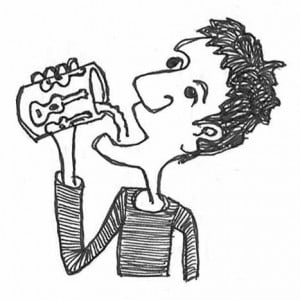
Don’t rush it. Things are going well, and you deserve a nice cup of tea.
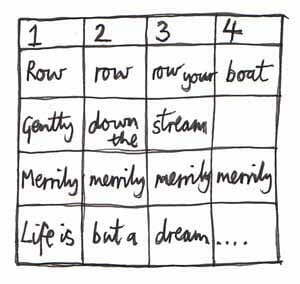
When you play music, it’s important to play on the beat. Most popular music has a 4/4 beat, which means there are 4 beats in every bar. That’s why you often hear people saying “A-one, a-two, a-one, two, three, four,” to count in a groovy tune. So by thinking of music as evenly spaced groups of 4 beats, we can begin to get going.
Now you will use the C chord to play a song, the children’s tune Row, Row, Row Your Boat. This whole song can be played using only this one chord. By counting a steady 1,2,3,4,1,2,3,4,1,2,3,4 as you sing the song, you will find that certain words fall on certain beats. Here’s the song written out in beats.
The first challenge is to put two elements together: singing and playing. Play four strums for each line of the tune (one strum of your C chord for each beat), and sing the tune while you do it. The first note to sing is a C, for ‘Row, row, row”. Have a go strumming along with this clip:
If you like the idea of playing songs with only one chord, you can play along with me on three more below – Bob Marley’s Get Up, Stand Up using only an Am chord, Them’s Baby Please Don’t Go, and Harry Nilsson’s Coconut song using only a C7 chord.
All the shapes for these chords are on the FREE UKULELE CHORD SHEETS.
You are doing well, click on the button below to start your next lesson.
